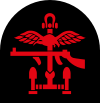| No. 4 Commando | |
|---|---|
 No. 4 Commando after a raid on France, April 1942. | |
| Active | 1940–1946 |
| Country | |
| Allegiance | |
| Branch | Special Services Group |
| Type | Commando |
| Role | Amphibious warfare Close-quarters combat Coastal raiding Cold-weather warfare Direct action Forward observer Raiding Reconnaissance Urban warfare |
| Size | 500 all ranks |
| Part of | 1st Special Service Brigade 4th Special Service Brigade |
| Nickname(s) | Cavalry Commando[1] |
| Engagements | Second World War Operation Claymore Operation Abercrombie Dieppe raid Normandy landings Battle of the Scheldt |
| Commanders | |
| Notable commanders | Lord Lovat |
| Insignia | |
| Combined Operations tactical recognition flash |  |
No. 4 Commando was a battalion-sized Commando unit of the British Army during the Second World War formed in 1940. Although it was intended to conduct small-scale raids and harass enemy garrisons along the coast of German-occupied France, the unit was mainly employed as a highly trained infantry assault unit.
The unit's first operation was the successful raid on the Lofoten Islands on 4 March 1941. However, their next two planned operations were both cancelled and it was not until 22 April 1942 that No. 4 Commando took part in another raid on the French coastal town of Hardelot. On 22 August 1942, No. 4 Commando was one of three Commando units selected for the Dieppe raid. Under the command of Lord Lovat, the unit landed on the right flank of the main landings and successfully silenced a German gun battery. This was the only complete success of the operation, which was eventually aborted, after less than 10 hours, following heavy Allied losses.
As part of the 1st Special Service Brigade, No. 4 Commando took part in the Normandy landings in June 1944. Landing on Sword Beach 30 minutes before the rest of the brigade, their first objectives were to capture a German strong point and gun battery in Ouistreham. After the unit neutralised these positions they rejoined the brigade, reinforcing the 6th Airborne Division at the Orne bridges. Before the invasion, the brigade had been informed that they would stay in France for only a few days. No. 4 Commando remained there for a further 82 days, protecting the beachhead's left flank. During that period,the unit endured over 50% casualties. Finally withdrawn to Britain in September 1944, they were reassigned to the 4th Special Service Brigade for the assault on Walcheren island. At the end of the war No. 4 Commando became part of the British Army of the Rhine, but together with all of the British Army's Commando units was disbanded in 1946.
- ^ Dunning 2003, p. 15
© MMXXIII Rich X Search. We shall prevail. All rights reserved. Rich X Search
